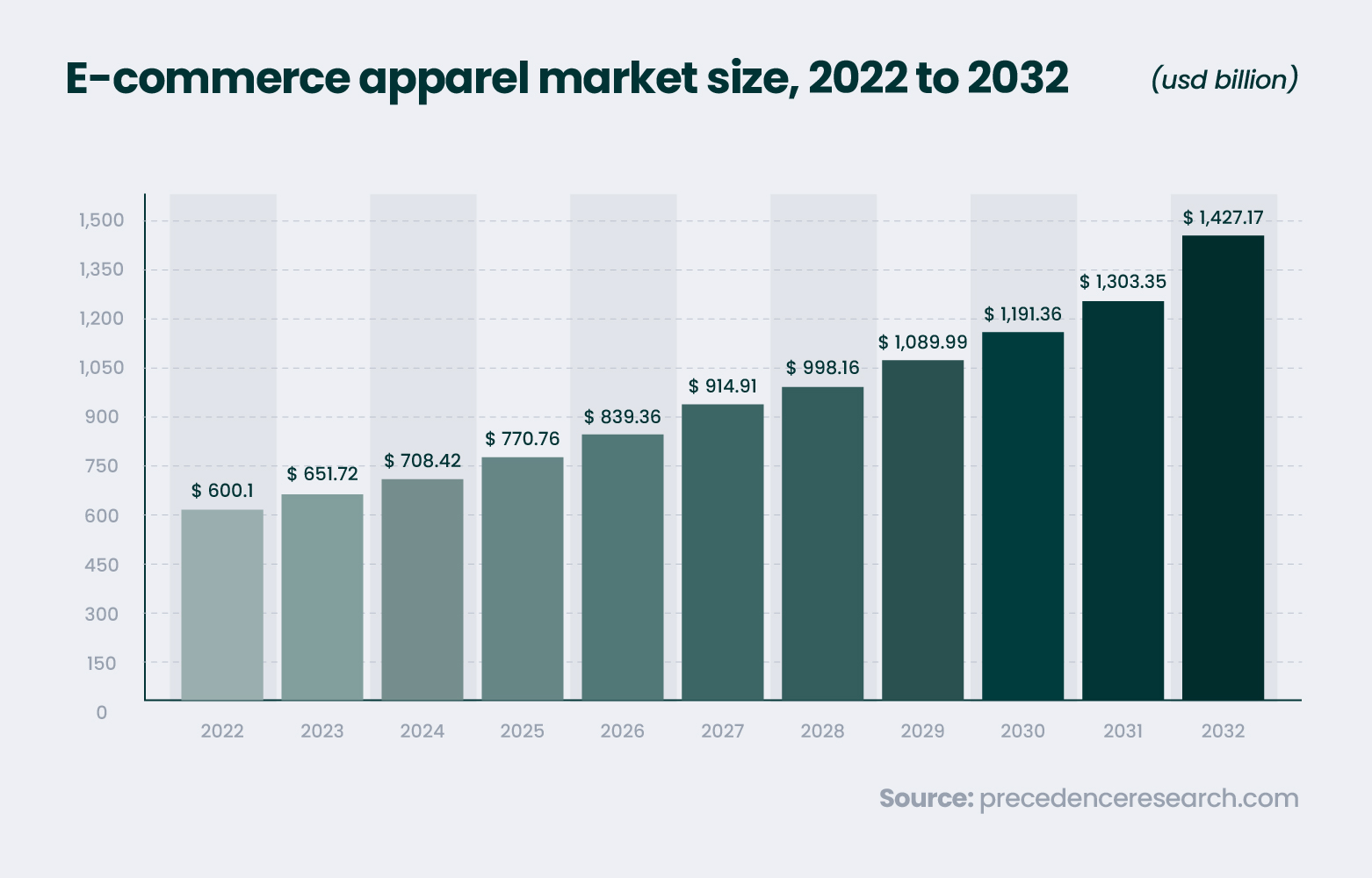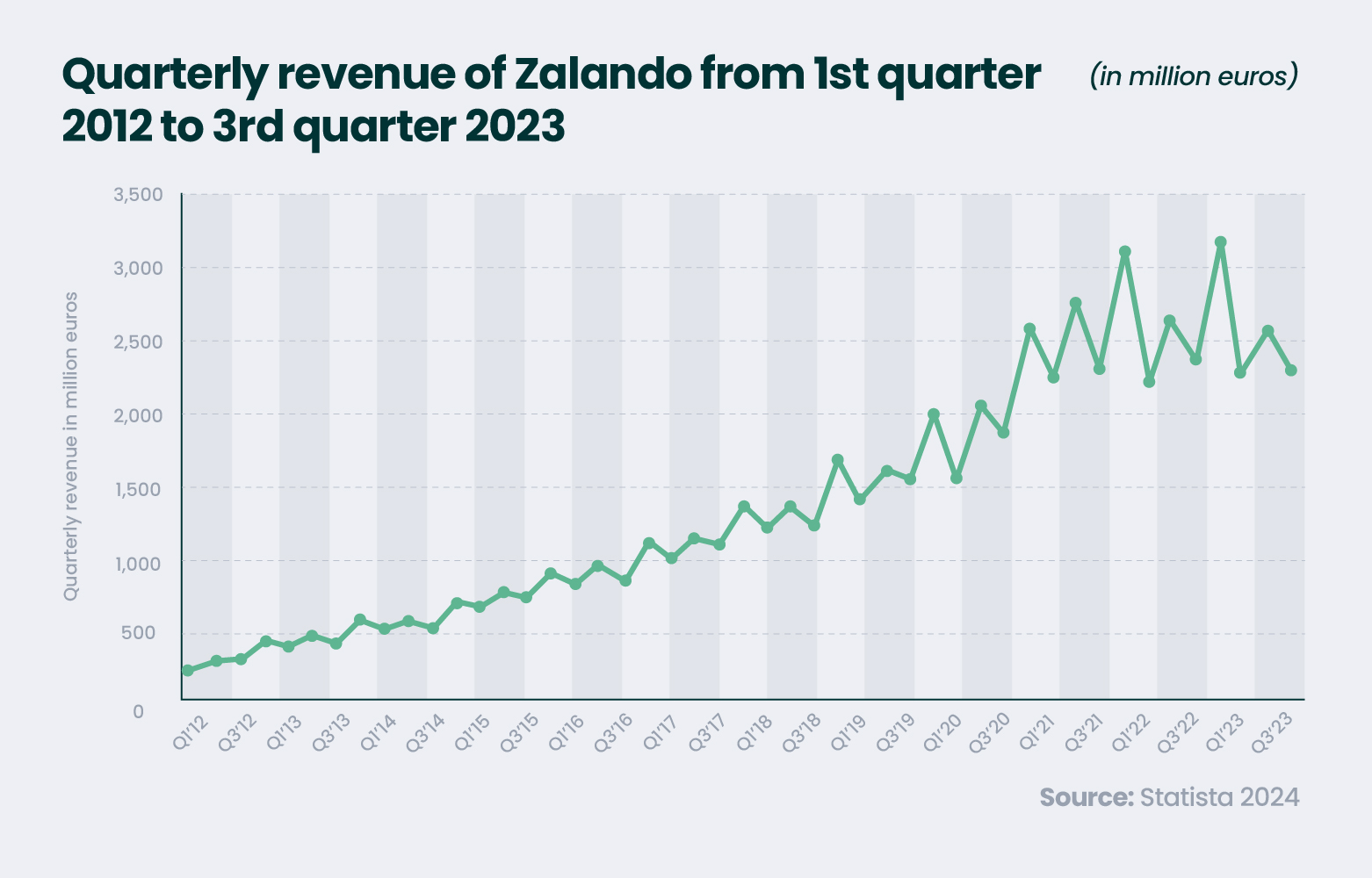To be in vogue or not to be in vogue – that is not the question when it comes to e-commerce that penetrates all industries. Clothing business is no exception to the rules.
According to Precedence Research, in 2022, the global e-commerce apparel market size reached $600,11 billion, but it is projected to hit around $ 1,427,17 billion with a growth rate of 9,1 % by 2032.

What are the reasons for the popularity of e-commerce in the fashion industry?
First, more and more people are using online stores for their apparel purchases. In 2024, retail e-commerce sales were $6,3 trillion worldwide. Second, e-commerce is now an essential tool for the fashion vertical. For example, fashion brands like Zara, Koton, boohoo, and Shein Technology LCC have become exceptional e-commerce clothing websites for a broad global audience.
So, we can say with confidence that e-commerce transforms the fashion industry and influences the market situation. What are the key online marketplace trends? And what awaits e-commerce clothing websites? We’ll cover that further down, so keep reading.
Benefits You’ll Get with an E-commerce Clothing Website
Not all fashion brands have e-commerce clothing websites, but this is just a matter of time. When they’re aware of the benefits they can get from marketplaces, they will prioritize online stores as much as brick-and-mortar shops and boutiques. So, let’s reveal how e-commerce can become the runway for fashion brands.
- Broad audience. One of the driving forces behind the popularity of apparel marketplaces is their unparalleled reach. Fashion platforms are becoming hubs for potential clients, contributing to better brand awareness and increased sales. Plus, with e-commerce clothing websites, companies are free from geographic constraints and can reach their clients globally.
- Increased sales. Another reason why fashion brands opt for marketplaces is their desire to boost their sales. And it truly works. For example, a Germany-based online fashion marketplace, Zalando, earned over 2,3 billion euros in 2023. The company has a substantial customer base of over 50 million in 23 European countries.
- Ready-made infrastructure. Starting a brick-and-mortar store can be a challenging task full of obstacles. But e-commerce clothing websites provide a ready-made infrastructure with an established customer base and efficient payment systems. This offers an easier way for emerging fashion brands to build their online presence.
- Efficient payment system. E-commerce websites offer robust payment gateways, enabling quick and secure purchasing processes. As a result, customers can feel safe and secure when sharing their payment information. By offering convenient payment methods such as Apple Pay or Google Wallet, e-commerce clothing websites can attract more shoppers.
- Global expansion. Marketplaces can be efficient means of entering the global market. Thus, this is a chance for fashion brands to speed up geographic expansion and overcome hurdles associated with opening physical stores in new regions. For example, ASOS is one of the biggest e-commerce clothing websites with 1,000 brands, operating in 196 countries.
Online Marketplace Trends to Consider in 2024
No doubt, e-commerce brings many opportunities and benefits. From secure services to dynamic and responsive communities, e-commerce clothing websites are transforming into more unique and advanced online stores. But what to expect from them in the future? Let’s discover what can help e-commerce platforms gain a competitive edge and succeed in the fierce rivalry.
Customized product offerings
Personalization is more than a trend, it is already a key strategy used by fashion e-commerce to drive customer engagement and sales. Leading e-commerce clothing websites like Zara, ASOS, and Amazon Fashion apply customization to product offerings.
For example, Zara analyzes customer’s browsing and purchase history to offer them tailored product recommendations online. As a result, this fashion brand manages to provide a more personalized shopping experience.
When it comes to Amazon Fashion, it also uses recommendation engines by analyzing users’ activities and recommending clothes, shoes, and accessories aligning with their preferences. Such a strategy assists this e-commerce clothing website in creating products that are interesting for its target audience.
ASOS also adapts its website content to customer behavior by making it catching and dynamic. As a result, customers can see only relevant content based on their recent search activity.
AI-based algorithms for personal recommendations
Fashion brands integrate AI-powered tools into their e-commerce clothing websites to provide real-time customer support, assist with size queries, and offer customized product recommendations. AI algorithms analyze consumer behavior to gain insights into their interests, preferences, and current needs. For example, browsing history can be used by AI to create personalized recommendations.
AI implementation into e-commerce platforms allows for adapting to changes in consumer behavior. By analyzing historical data, AI unveils valuable insights about consumer preferences and makes them more accurate over time.
For example, Gucci applies chatbots and live chat to ensure customer support across multiple channels. By offering personalized shopping, this fashion brand creates a more meaningful experience for the target audience.
Loyalty programs for enhanced customer experience
Fashion retailers offer loyalty programs to enhance customer experience and extend the client base. Additionally, loyalty schemes involve data gathering for personalized services and advanced marketing efforts. From point-based and subscription-based loyalty programs to reward and partner loyalty programs, retailers offer them to customers to better respond to their preferences.
For example, Nordstrom has a customized and sophisticated program based on customer spending and purchase history. This loyalty program encourages customers to repeat purchases. For the company, this is a chance to keep consumers engaged and satisfied.
Omnichannel retail strategies for a seamless shopping experience
Selling through multiple channels is another trend in the fashion industry. Companies feel a strong need to expand beyond a single e-commerce clothing website and develop various digital and traditional channels. This omnichannel strategy allows for the extension of physical and digital reach. Whether this is an e-commerce clothing website, marketplace, mobile app, or a brick-and-mortar store – each channel presents numerous opportunities for fashion brands.
The value of e-commerce integration is that it contributes to the delivery of a seamless and unified shopping experience across diverse channels. Additionally, this is a chance to ensure credibility and trust. For example, the presence of e-commerce clothing brands on established marketplaces such as Etsy, eBay, and Amazon can help them create trustworthy relationships with customers.
Social commerce for better connecting with the audience
Social commerce is a driving force in the growth of e-commerce clothing websites, transforming how they connect with their customers. What’s more, social commerce drives sales. A seamless merging of social media with online shopping breaks down barriers between them and allows customers to purchase products without leaving social apps.
Influencer marketing has become an integral part of social commerce. Fashion brands involve celebrities and influencers to market their products through social media. As a result, influencers connect e-commerce clothing websites with their followers by making them a target audience. For example, Zara and H&M use TikTok to showcase their latest collections, directly linking users to their online stores.
The integration of AR technology
The integration of AR technology into an e-commerce clothing website is another trend used by fashion brands to innovate and captivate their target audience. The value of augmented reality is that it merges the digital and physical worlds. From a try-before-you-buy approach and personalized fit visualization to enhance online engagement and sustainable fashion practices, these are benefits that e-commerce clothing websites try to deliver to their clients.
Famous fashion brands, such as Gucci, Adidas, Nike, Burberry, Tomy Hilfiger, and Zara use AR to provide innovative solutions ranging from unique marketing experiences to virtual try-ons. For example, Nike uses AR tools for sneaker releases, enabling customers to try on shoes through their app in real time.
Sustainable and ethical fashion
More and more consumers are paying more attention to the quality and sustainability of their clothing choices. Therefore, fashion brands try to offer stylish designs crafted with longevity, care, and eco-friendliness in mind.
Apparel companies tend to prioritize a lower carbon footprint, ethical sourcing, and premium materials. No doubt, this is a good way to reach a conscious target audience. But this is also a way to improve business reputation and image in the market. This growing fashion trend shows a change in values and establishes new standards for e-commerce clothing websites in 2024.
How Forbytes Approaches Digital Transformation of E-Commerce Clothing Websites
At Forbytes, we have an on-point story to share about how we contributed to the digital transformation of our client’s e-commerce clothing website.
Stenströms is an elite fashion brand, well-known in Europe and North America, boasting a wide distribution network. The company has 103 stores in the USA, 131 – in Belgium, 116 – in Germany, 166 – in Sweden, and more.
Initially, Stenströms managed to respond to their customers’ needs, staying committed to their personalized clothing design and product. But over time, the number of clients was increasing, and the company faced the dilemma of how to avoid performance drops and cater to the needs of all clients by saving their personalized approach.
Therefore, Stenströms turned to Forbytes to build business automation software to reduce manual work and the number of mistakes and delays and make their business more efficient. So see how we approached our client’s challenge.
First, Forbytes built a Made-to-Measure (MTM) system to automate order processing to save time for retailers, speed up production, and increase the number of custom-made shirts. As a result, Stenströms succeeded in providing their clients with high-quality clothing items.
Second, we ensured the MTM system we built, would allow for instant order and client measurement verification and validation. We helped our client avoid mistakes, delays, and poor use of resources. As a result, retailers could provide clients with perfectly tailored products.
So, the digital transformation of an e-commerce clothing website is a continued process that involves adopting new trends and integrating the latest technologies.
Final Thoughts
All in all, the fashion industry doesn’t stand still and demonstrates steady growth driven by digital trends. The main reasons why fashion businesses tend to transform into e-commerce clothing websites are a broader audience, increased sales, and global expansion. From AR and AI-based algorithms to omnichannel retail strategies and customized offerings, these are key trends fashion companies integrate to transform their business.
At Forbytes, we offer digital transformation services by turning your brick-and-mortar stores into e-commerce clothing websites to ensure online presence and extend the target audience. This enables businesses to boost sales and increase revenues. Our e-commerce expertise will help your company better connect with customers, ensure selling through multiple channels, and enhance customer experience.
Do you want to digitalize your solution together with Forbytes? Apply here for our team! We’re looking forward to connecting with you!











